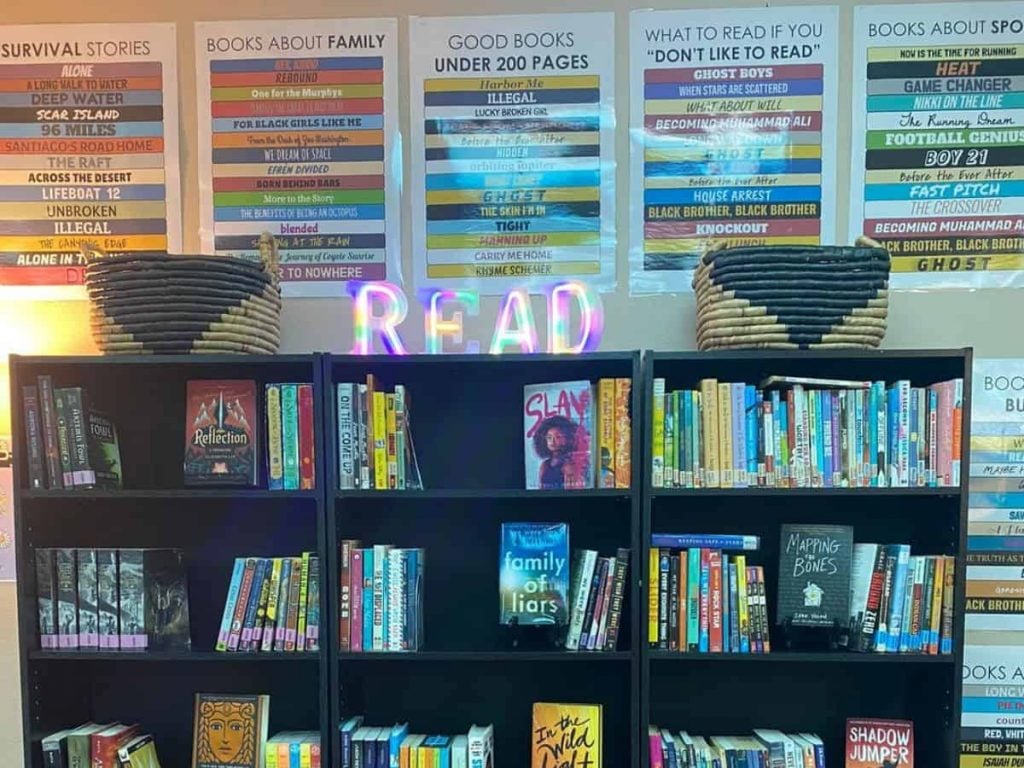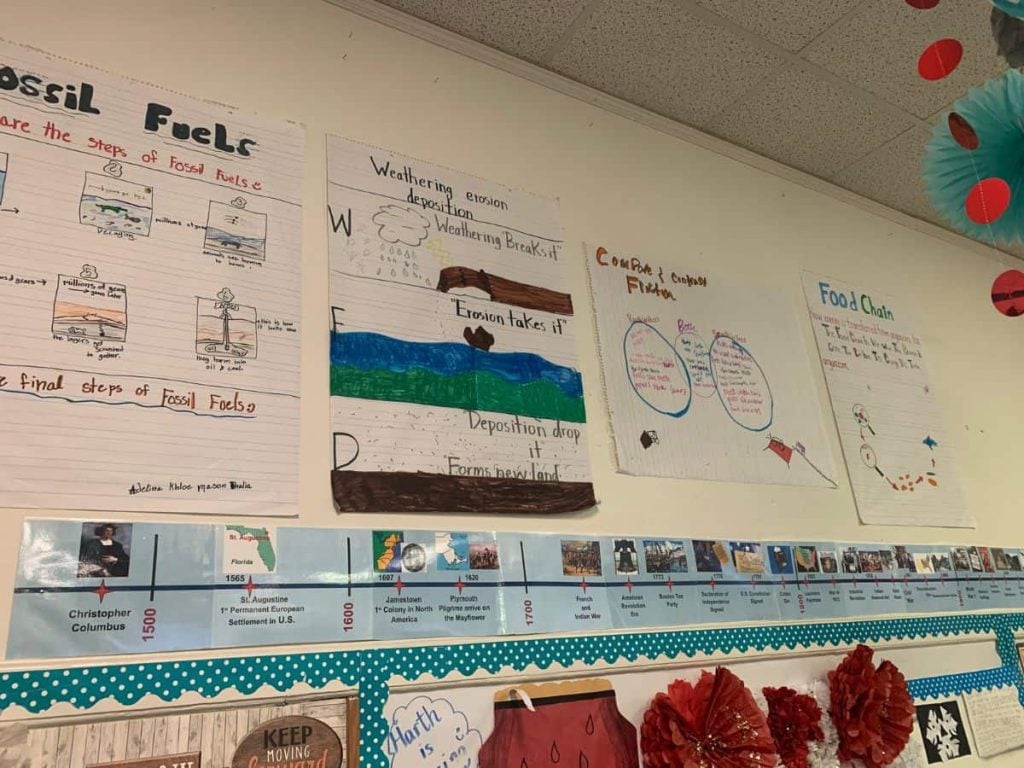13 Ways to Build a Literacy Rich Environment in Your Classroom
If you’re trying to learn what it means to create a literacy rich environment for your classroom, you’ve come to the right spot. These are fancy words for a pretty simple concept: enveloping kids in words, books, and language in all its forms.
Why is a literacy-rich environment important?
This Stanford study showed that as early as 18 months, children from lower-income families had lower language processing speeds than more privileged children. There are many reasons why it’s true, but there are far fewer words directed at children living in poverty than those who are wealthier.
In order to overcome this deficit, classroom teachers can ensure that their spaces are considered literacy-rich environments. When kids are constantly engaged in language development and surrounded by words in both print and spoken dialogue, they develop at a faster rate.
How do you provide a literacy-rich environment?
To provide a literacy-rich environment, you should remember that listening and speaking are foundational to language and literacy development. That means that math and science classrooms can absolutely create a literacy-rich environment anytime they have students discuss or argue whether an answer is correct, record their thinking on a digital platform as they solve a problem, describe the weather, or explain to friends about a hypothesis.
As long as teachers are creating assignments that require students to isolate their listening skills (rather than relying on visual aids), practice speaking like a scholar, read for any purpose, or write across the curriculum, they’re fostering a literacy-rich environment in their classroom spaces.
To learn more about specific examples of a literacy rich environment, keep reading!
What are the characteristics of a literacy-rich environment?
Literacy-rich environments are simply spaces that envelope students in written language. Here are some wonderful examples from my own elementary school, which is a dual language campus.
Scholar Talk
Scholar talk is when the teacher has trained students to answer in complete sentences, and then respond to one another with sentence stems like, “I agree with (classmates) because…” or “I disagree with (classmate), since the text says…”
When we encourage kids to speak in complete sentences and engage in meaningful dialogue about content – no matter the subject area – we are engaging in scholar talk. This can begin as early as kindergarten.
Sound Walls
Sound walls are beginning to replace word walls in classrooms, and for teachers with lots of space, you’ll often find both!
Sound walls can look many different ways, but one way is shown below. Students in pre-k and kindergarten are shown how to make different letter sounds with their mouths.
The science of teaching reading has taught us that children learn to read by mastering sounds first before even being exposed to letters in written form.

Dual Language Classrooms
This isn’t something you have control over, but some of the most literacy rich environments in our building are in our dual language classrooms. That’s because students are always paired with a “pareja” which means partner. One is English dominant and the other is Spanish dominant. These students help each other master the language they’re learning.
Lead4Ward Strategies
Lead4Ward has an instructional playlist that is fully of outstanding ideas to generate deep discussions in your class. And there’s nothing more important to a literacy rich environment than the quality of conversation taking place.
If you’ve never felt like a super creative teacher, this is your chance to really wow your kids and leadership team with activities that are literacy rich, engaging, and aligned to objectives.
Artist Statements
An art teacher can work toward a literacy-rich environment by asking students to write an author’s statement each time they complete a project.
Classroom Libraries
Check out my post about how to set up a reading corner in your classroom. Classroom libraries make some space for kids to read for enjoyment, and that’s so important for classroom culture. Avoid the temptation to put kids on Epic or some other online reading platform at every opportunity. A mixture of technology and old-fashioned reading is a balanced approach.

Display of Student Work
Student work on the walls is an easy way to increase the exposure to print in your room, especially since they’ll generate so much of it.
Designate a large bulletin board as your “refrigerator” where you can continually rotate your high quality work, making sure to include a space for every student.
Finally, add a second space in the hallway if you’re an elementary school teacher. This ensures that kids can enjoy seeing each other’s work while they wait in the hallways. It also gives your leadership team the opportunity to celebrate your hard work!
Partner and Group Work
Sometimes teachers with low noise tolerance will err on the side of too much independent work. After all, it’s easier to control a class that’s quiet, and it’s easier to get quality data about student understanding, too.
Nevertheless, lots of on-task discussion will move students toward growth faster than too much quiet time.
Reading for Enjoyment
Here’s another example of a classroom reading corner. This doesn’t only apply to RLA classrooms. History and science spaces could easily swap these books out for content-area texts and build in a classroom framework that allows kids some time to read, either as a whole class or a reward.

Writing Across the Curriculum
No matter what subject area you teach, your students should be writing. Math students can defend their answer choices, or describe their problem solving processes orally.
Science teachers can have students record their hypotheses or write reports about their experiment.
Social studies and history teachers can participate in research projects, term papers, and engage project-based learning with a writing component.
Read Alouds
Children learn to read with a sounds first approach, which means that a good old fashioned read aloud, where students gather around the teacher and listen to her read, is an excellent strategy. This can be effective all the way through middle school.
I can still remember listening to a daily dose of a chapter book from my 8th grade teacher. It was our favorite part of the RLA block.
Students with weaker reading comprehension and fluency can very much benefit from just listening to a strong reader.
Partner Reading and Choral Reading
There are many ways that students can read aloud in class without embarrassing them. Check out these fabulous alternatives to popcorn reading.
Student Generated Alphabet
This strategy is found in our dual language classrooms, but a smaller version could be created in a GedEd class, too. Students each choose a letter from a bucket, and are tasked with generating a word that begins with that letter. They draw their picture, and then use their best writing skills to write a short paragraph using the word.

Labels
Labeling everything in your classroom is a tedious but effective way to increase the amount of print in your classroom. This strategy can build students’ vocabularies, particularly in the lower grades.
Restorative Circles
Restorative circles are a great social emotional learning strategy for your classroom, but they also increase students’ language skills. Read about how they transformed my student behavior here.
Shared Journaling
I found this brilliant idea in a 5th grade classroom. The teacher created a bunch of composition book covers, each with a different prompt. By the end of the year, she’s got a journal entry from every student in each book.
There are so many ways you could use this strategy: in centers, whole group, or as an early finisher activity.
Giving students lots of opportunities to write is key to any literacy rich environment.

Seesaw and Flip
Seesaw and Flip are two educational technologies that give students opportunities to record their speaking and share with one another. This is just a techie way to support good dialogue in the classroom.
Interactive Notebooks
Interactive Notebooks are a great way for you to increase print exposure and writing across the curriculum. No matter what subject or grade level you teach, there are tons of ideas for implementing these in the classroom.

Poem in My Pocket Events
Our campus has a Poem in My Pocket day every April. Students create pocket necklaces with yarn and paper pockets and choose a poem or two to put in their pocket. All day long, they are encouraged to read a poem aloud to teachers and staff people. If they get a teacher to listen, the teacher provides them with a ticket that goes into a drawing. Obviously, the more tickets they turn in, the better their opportunity to win. 5th graders are even allowed to interrupt instruction to read to entire classes across the building.
Honestly, it’s pretty exhausting to teachers, and we try to schedule a bit less content that day. But it’s really wonderful for students, so we fall in line and do it!
Word Walls
Word Walls may be a bit old fashioned, but they really are important. I like to put my words on a binder ring so that students can take the words to their table for spelling. For example, as words come up in class, I’ll write them on notecards and add them to the binder rings. If a student needs to remember how to spell the word “excellent,” they simply take the E ring to their table and flip through the cards.

Student Generated Anchor Charts
Student generated anchor charts are a great way to build student ownership of learning and increase the print in your classroom at the same time. Quit worrying about everything being beautiful, and focus on students doing the work.

Concluding Thoughts
I hope these concrete, practical ideas help you to realize that creating a literacy-rich environment isn’t as scary as it sounds. Most teachers do it every day without realizing it. But can you add a few of these ideas and continue to grow in your teaching practice? That’s the idea, after all!
